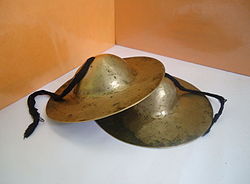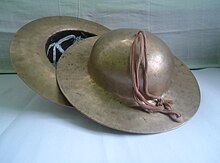Taal (instrument)
 |
The taal (Template:Lang-as; Template:Lang-or, Gini ), manjira (also spelled manjīrā or manjeera), jalra, or gini is a pair of clash cymbals,[1] which make high-pitched percussion sounds. In its simplest form, it consists of a pair of small hand cymbals.[2] The word taal comes from the Sanskrit word Tālà, literally means a clap. It is a part of Indian music and culture, used in various traditional customs e.g. Bihu music, Harinaam etc.It is a type of Ghana vadya.
In Hindu religious contexts it is known as karatalas (Template:Lang-sa, IAST: Karatāḷaṁ), pronounced "karataala", (literally beat-tala hand -kara), typically used to accompany devotional music such as bhajan and kirtan. They are commonly used by Hare Krishna devotees when performing harinam, but are ubiquitous to all Hindu devotional music.
Materials used

The clash cymbal, taal is made of bell metals i.e. bronze, brass, copper, zinc etc. Each cymbal is connected with a cord which passes through hole in its center. The pitch of different types of taal vary according to their size, weight and the materials used. A player can also adjust the timbre by varying the point of contact while playing.
Manjiras are usually made of bronze, brass, copper, or zinc. The name manjira or khartal can also refer to a similar instrument made of a wooden frame with rows of cymbals inside.

Types
There are many types of Taal, categorised by size, weight and appearance.
- Bortaal (Template:Lang-as) is the big size clash cymbal, Its weight approx. 1½−2 kg. The player who plays Bortaal is called in Assam as Gayan. Bortaal is a symbol of Assamese traditional culture. Sometimes, the players perform dance-music with both e.g. in Gayan-Bayan, Bortaal Nritya etc. Sometimes the player perform with only music e.g. in Harinaam, Dihanaam etc. The rhythmic high-pitched sound of the Bortaal makes the surroundings pure and sacred.
- Majutaal (Template:Lang-as) is medium size clash cymbal,
- Khutitaal or Harutaal (Template:Lang-as) is small size clash cymbal.[3] It is also known name as Manjira. It is generally used in traditional, folk and classical music in India. It is also used in dance in Bharat Natyam, Kuchipudi Manipuri Mohiniattam Andhra Natyam Kathakali This Instrument has some other names e.g. thaaleaj (Kashmir), taalam, tala, jalra etc.[4]
- Ramtaal or Khoritaal (Template:Lang-as) are two wooden handled musical instruments, containing multiple pairs of small cymbals. It is generally known India as Khartal.
Uses
Manjiras are commonly played in folk and devotional music. They are played in various religious events and ceremonies in India and especially in bhajans. Manjiras are ancient musical instruments. Manjiras can be seen in many ancient temple pictures.
Gujarati folk music
Manjiras have a significant importance in Gujarati and Marathi folk music. In Maharashtra they are known as Taal (टाळ). Initially Manjiras were played in aarti. In Gujarat and Maharashtra, manjiras hold great importance and are played in bhajan, santvani and dayro.
See also
Other instruments in Hinduism
- Bhajan
- Khol
- Maddale, an instrument used in Yakshagana
- Manjira
- Mrdanga
- Mridangam
- Tabla
- Thavil
- Tingsha
Gadam
References
- ^ "Solid Instrument Article, Musical Instruments: Solids, Solid Instrument From New Delhi, Solid Instrument Musical Instrument, Popular Solid Instrument, New Delhi Based Solid Instrument". 4to40.com. 2007-03-14. Retrieved 2013-02-28.
- ^ Caudhurī, Vimalakānta Rôya (2007). The Dictionary Of Hindustani Classical Music. Delhi, India: Motilal Banarsidass. p. 173. ISBN 978-81-208-1708-1., originally published in 2000
- ^ https://web.archive.org/web/20110701131637/http://enajori.com/culture/instruments/instruments1.html. Archived from the original on July 1, 2011. Retrieved July 24, 2011.
{{cite web}}: Missing or empty|title=(help); Unknown parameter|deadurl=ignored (|url-status=suggested) (help) - ^ Courtney, David. "Manjira – Indian hand cymbals". Chandrakantha.com. Retrieved 2013-02-28.
